Thermoelectric Properties of NiCl3 Monolayer: A First-Principles-Based Transport Study
Abstract
1. Introduction
2. Computational Process
3. Results and Discussion
3.1. Crystal and Electronic Structures
3.2. Thermoelectric Properties
4. Conclusions
Author Contributions
Funding
Conflicts of Interest
References
- McGuire, M.A. Crystal and magnetic structures in layered, transition metal dihalides and trihalides. Crystals 2017, 7, 121. [Google Scholar] [CrossRef]
- Huang, B.; Clark, G.; Moratalla, E.N.; Klein, D.R.; Cheng, R.; Seyler, K.L.; Zhong, D.; Schmidgall, E.; McGuire, M.A.; Cobden, D.H.; et al. Layer-dependent ferromagnetism in a van der Waals crystal down to the monolayer limit. Nature 2017, 546, 270–273. [Google Scholar] [CrossRef] [PubMed]
- McGuire, M.A.; Yan, J.Q.; Kelley, P.L.; May, A.F.; Cooper, V.R.; Lindsay, L.; Puretzky, A.; Liang, L.B.; Santosh, K.C.; Cakmak, E.; et al. High-temperature magnetostructural transition in van der Waals-layered α-MoCl3. Phys. Rev. Mater. 2017, 1, 064001. [Google Scholar] [CrossRef]
- Seyler, K.L.; Zhong, D.; Klein, D.R.; Gao, S.Y.; Zhang, X.O.; Huang, B.; Moratalla, E.N.; Yang, L.; Cobden, D.H.; McGuire, M.A.; et al. Ligand-field helical luminescence in a 2D ferromagnetic insulator. Nat. Phys. 2018, 14, 277–281. [Google Scholar] [CrossRef]
- Zhang, W.B.; Qu, Q.; Zhu, P.; Lam, C.H. Robust intrinsic ferromagnetism and half semiconductivity in stable two-dimensional single-layer chromium trihalides. J. Mater. Chem. C 2015, 3, 12457–12468. [Google Scholar] [CrossRef]
- Liu, J.Y.; Sun, Q.; Kawazoe, Y.; Jena, P. Exfoliating biocompatible ferromagnetic Cr-trihalide monolayers. Phys. Chem. Chem. Phys. 2016, 18, 8777–8784. [Google Scholar] [CrossRef]
- Zhou, Y.G.; Lu, H.F.; Zu, X.T.; Gao, F. Evidencing the existence of exciting half-metallicity in two-dimensional TiCl3 and VCl3 sheets. Sci. Rep. 2016, 6, 19407. [Google Scholar] [CrossRef]
- He, J.J.; Ma, S.Y.; Lyu, P.B.; Nachtigall, P. Unusual Dirac half-metallicity with intrinsic ferromagnetism in vanadium trihalide monolayers. J. Mater. Chem. C 2016, 4, 2518–2526. [Google Scholar] [CrossRef]
- Weber, D.; Schoop, L.M.; Duppel, V.; Lippmann, J.M.; Nuss, J.; Lotsch, B.V. Magnetic properties of restacked 2D spin 1/2 honeycomb RuCl3 nanosheets. Nano Lett. 2016, 16, 3578–3584. [Google Scholar] [CrossRef]
- He, J.J.; Li, X.; Lyu, P.B.; Nachtigall, P. Near-room-temperature Chern insulator and Dirac spin-gapless semiconductor: Nickel chloride monolayer. Nanoscale 2017, 9, 2246–2252. [Google Scholar] [CrossRef]
- Sheng, X.L.; Nikolic, B.K. Monolayer of the 5d transition metal trichloride OsCl3: A playground for two-dimensional magnetism, room-temperature quantum anomalous Hall effect, and topological phase transitions. Phys. Rev. B 2017, 95, 201402. [Google Scholar] [CrossRef]
- Sarikurt, S.; Kadioglu, Y.; Ersan, F.; Vatansever, E.; Akturk, O.; Yuksel, Y.; Akinci, U.; Akturk, E. Electronic and magnetic properties of monolayer RuCl3: A first-principles and Monte Carlo study. Phys. Chem. Chem. Phys. 2018, 20, 997–1004. [Google Scholar] [CrossRef] [PubMed]
- Iyikanat, F.; Yagmurcukardes, M.; Senger, R.; Sahin, H. Tuning electronic and magnetic properties of monolayer α-RuCl3 by in-plane strain. J. Mater. Chem. C 2018, 6, 2019–2025. [Google Scholar] [CrossRef]
- Sun, Q.L.; Kioussis, N. Prediction of manganese trihalides as two-dimensional Dirac half-metals. Phys. Rev. B 2018, 97, 094408. [Google Scholar] [CrossRef]
- Ersan, F.; Vatansever, E.; Sarikurt, S.; Yuksel, Y.; Kadioglu, Y.; Ozaydin, H.D.; Akturk, O.U.; Akinci, U.; Akturk, E. Exploring the electronic and magnetic properties of new metal halides from bulk to two-dimensional monolayer: RuX3 (X=Br, I). J. Magn. Magn. Mater. 2019, 476, 111–119. [Google Scholar] [CrossRef]
- Tomar, S.; Ghosh, B.; Mardanya, S.; Rastogi, P.; Bhadoria, B.S.; Chauhan, Y.S.; Agarwal, A.; Bhowmick, S. Intrinsic magnetism in monolayer transition metal trihalides: A comparative study. J. Magn. Magn. Mater. 2019, 489, 165384. [Google Scholar] [CrossRef]
- Zhang, W.X.; Li, Y.; Jin, H.; She, Y.C. Two-dimensional transition-metal halide CoBr3 with spin-polarized Dirac cone. Phys. Chem. Chem. Phys. 2019, 21, 17740. [Google Scholar] [CrossRef]
- Wang, X.T.; Li, T.Z.; Cheng, Z.X.; Wang, X.L.; Chen, H. Recent advances in Dirac spin-gapless semiconductors. Appl. Phys. Rev. 2018, 5, 041103. [Google Scholar] [CrossRef]
- Mahan, G.D.; Sofo, J.O. The best thermoelectric. Proc. Natl. Acad. Sci. USA 1996, 93, 7436–7439. [Google Scholar] [CrossRef]
- DiSalvo, F.J. Thermoelectric cooling and power generation. Science 1999, 285, 703–706. [Google Scholar] [CrossRef]
- Snyder, G.J.; Toberer, E.S. Complex thermoelectric materials. Nat. Mater. 2008, 7, 105–114. [Google Scholar] [CrossRef]
- Hicks, L.D.; Dresselhaus, M.S. Effect of quantum-well structures on the thermoelectric figure of merit. Phys. Rev. B 1993, 47, 12727–12731. [Google Scholar] [CrossRef] [PubMed]
- Hicks, L.D.; Dresselhaus, M.S. Thermoelectric figure of merit of a one-dimensional conductor. Phys. Rev. B 1993, 47, 16631–16634. [Google Scholar] [CrossRef] [PubMed]
- Dresselhaus, M.S.; Chen, G.; Tang, M.Y.; Yang, R.G.; Lee, H.; Wang, D.Z.; Ren, Z.F.; Fleurial, J.P.; Gogna, P. New directions for low-dimensional thermoelectric materials. Adv. Mater. 2007, 19, 1043–1053. [Google Scholar] [CrossRef]
- Hung, N.T.; Hasdeo, E.H.; Nugraha, A.R.T.; Dresselhaus, M.S.; Saito, R. Quantum Effects in the Thermoelectric Power Factor of Low-Dimensional Semiconductors. Phys. Rev. Lett. 2016, 117, 036602. [Google Scholar] [CrossRef]
- Chen, X.R.; Huang, Y.H.; Liu, J.; Yuan, H.K.; Chen, H. Thermoelectric performance of two-dimensional AlX (X = S, Se, Te): A first-principles-based transport study. ACS Omega 2019, 4, 17773–17781. [Google Scholar] [CrossRef]
- Kresse, G.; Hafner, J. Ab initio molecular dynamics for liquid metals. Phys. Rev. B 1993, 47, 558–561. [Google Scholar] [CrossRef]
- Kresse, G.; Hafner, J. Ab initio molecular-dynamics simulation of the liquid-metal-amorphous-semiconductor transition in germanium. Phys. Rev. B 1994, 49, 14251–14269. [Google Scholar] [CrossRef]
- Kresse, G.; Furthmuller, J. Efficiency of ab-initio total energy calculations for metals and semiconductors using a plane-wave basis set. Comput. Mater. Sci. 1996, 6, 15–50. [Google Scholar] [CrossRef]
- Blochl, P.E. Projector augmented-wave method. Phys. Rev. B 1994, 50, 17953–17979. [Google Scholar] [CrossRef]
- Perdew, J.P.; Burke, K.; Ernzerhof, M. Generalized gradient approximation made simple. Phys. Rev. Lett. 1996, 77, 3865–3868. [Google Scholar] [CrossRef] [PubMed]
- Monkhorst, H.J.; Pack, J. Special points for Brillouin-zone integrations. Phys. Rev. B 1976, 13, 5188–5192. [Google Scholar] [CrossRef]
- Madsen, G.K.H.; Singh, D.J. BoltzTraP. A code for calculating band-structure dependent quantities. Comput. Phys. Commun. 2006, 175, 67–71. [Google Scholar] [CrossRef]
- Bilc, D.I.; Hautier, G.; Waroquiers, D.; Rignanese, G.M.; Ghosez, P. Low-Dimensional transport and large thermoelectric power factors in bulk semiconductors by band engineering of highly directional electronic states. Phys. Rev. Lett. 2015, 114, 136601. [Google Scholar] [CrossRef]
- He, J.; Amsler, M.; Xia, Y.; Naghavi, S.; Hegde, V.; Hao, S.; Goedecker, S.; Ozolins, V.; Wolverton, C. Ultralow thermal conductivity in full Heusler semiconductors. Phys. Rev. Lett. 2016, 117, 046602. [Google Scholar] [CrossRef]
- Wickramaratne, D.; Zahid, F.; Lake, R.K. Electronic and thermoelectric properties of van der Waals materials with ring-shaped valence bands. J. Appl. Phys. 2015, 118, 075101. [Google Scholar] [CrossRef]
- Cai, Y.Q.; Zhang, G.; Zhang, Y.W. Polarity-reversed robust carrier mobility in monolayer MoS2 nanoribbons. J. Am. Chem. Soc. 2014, 136, 6269–6275. [Google Scholar] [CrossRef]
- Long, M.Q.; Tang, L.; Wang, D.; Wang, L.J.; Shuai, Z.G. Theoretical predictions of size-dependent carrier mobility and polarity in graphene. J. Am. Chem. Soc. 2009, 131, 17728–17729. [Google Scholar] [CrossRef]
- Hung, N.T.; Nugraha, A.R.T.; Saito, R. Two-dimensional InSe as a potential thermoelectric material. Appl. Phys. Lett. 2017, 111, 092107. [Google Scholar] [CrossRef]
- Jiang, P.H.; Liu, H.J.; Cheng, L.; Fan, D.D.; Zhang, J.; Wei, J.; Liang, J.H.; Shi, J. Thermoelectric properties of gamma-graphyne from first-principles calculations. Carbon 2017, 113, 108–113. [Google Scholar] [CrossRef]
- Liao, B.; Zhou, J.; Qiu, B.; Dresselhaus, M.S.; Chen, G. Ab initio study of electron-phonon interaction in phosphorene. Phys. Rev. B 2015, 91, 235419. [Google Scholar] [CrossRef]
- Bardeen, J.; Shockley, W. Deformation potentials and mobilities in non-polar crystals. Phys. Rev. 1950, 80, 72–80. [Google Scholar] [CrossRef]
- Fei, R.X.; Faghaninia, A.; Soklaski, R.; Yan, J.A.; Lo, C.; Yang, L. Enhanced thermoelectric efficiency via orthogonal electrical and thermal conductances in phosphorene. Nano Lett. 2014, 14, 6393–6399. [Google Scholar] [CrossRef] [PubMed]
- Dai, J.; Zeng, X.C. Titanium trisulfide monolayer: Theoretical prediction of a new direct-gap semiconductor with high and anisotropic carrier mobility. Angew. Chem. 2015, 54, 7572–7576. [Google Scholar] [CrossRef]
- Wang, J.; Xie, F.; Cao, X.H.; An, S.C.; Zhou, W.X.; Tang, L.M.; Chen, K.Q. Excellent thermoelectric properties in monolayer WSe2 nanoribbons due to ultralow phonon thermal conductivity. Sci. Rep. 2017, 7, 41418. [Google Scholar] [CrossRef] [PubMed]
- Zhang, J.; Liu, X.; Wen, Y.; Shi, L.; Chen, R.; Liu, H.; Shan, B. Titanium trisulfide monolayer as a potential thermoelectric material: A first-principles-Based Boltzmann transport study. ACS Appl. Mater. 2017, 9, 2509–2515. [Google Scholar] [CrossRef]
- Wang, F.Q.; Guo, Y.; Wang, Q.; Kawazoe, Y.; Jena, P. Exceptional thermoelectric properties of layered GeAs2. Chem. Mater. 2017, 29, 9300–9307. [Google Scholar] [CrossRef]
- Li, W.; Carrete, J.; Katcho, N.; Mingo, N. ShengBTE: A solver of the Boltzmann transport equation for phonons. Comput. Phys. Commun. 2014, 185, 1747–1758. [Google Scholar] [CrossRef]
- Li, W.; Lindsay, L.; Broido, D.; Stewart, D.; Mingo, N. Thermal conductivity of bulk and nanowire Mg2SixSn1−x alloys from first principles. Phys. Rev. B 2012, 86, 174307. [Google Scholar] [CrossRef]
- Li, W.; Mingo, N.; Lindsay, L.; Broido, D.; Stewart, D.; Katcho, N. Thermal conductivity of diamond nanowires from first principles. Phys. Rev. B 2012, 85, 195436. [Google Scholar] [CrossRef]
- Togo, A.; Oba, F.; Tanaka, I. First-principles calculations of the ferroelastic transition between rutile-type and CaCl2-type SiO2 at high pressures. Phys. Rev. B 2008, 78, 134106. [Google Scholar] [CrossRef]
- Sahin, H.; Cahangirov, S.; Topsakal, M.; Bekaroglu, E.; Akturk, E.; Senger, R.T.; Ciraci, S. Monolayer honeycomb structures of group-IV elements and III-V binary compounds: First-principles calculations. Phys. Rev. B 2009, 80, 155453. [Google Scholar] [CrossRef]
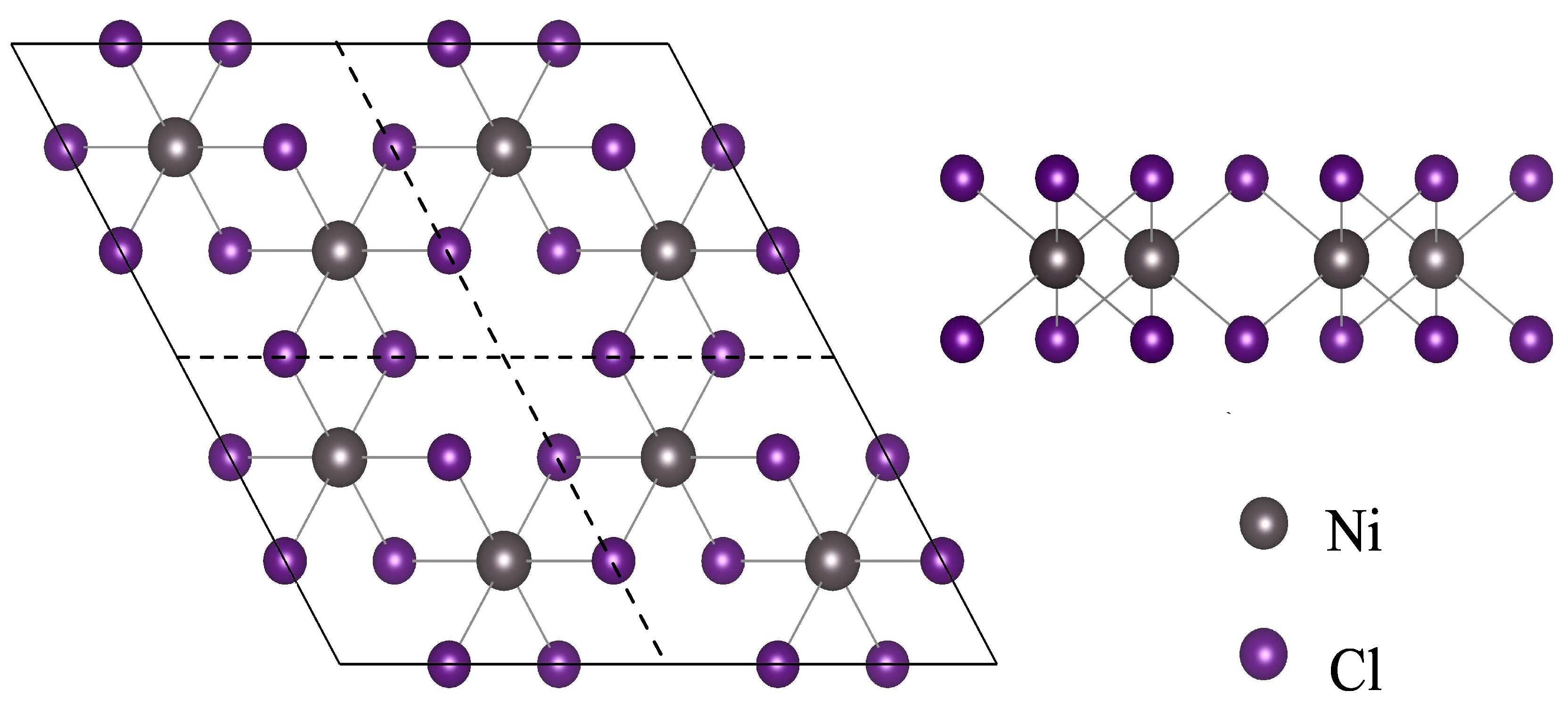
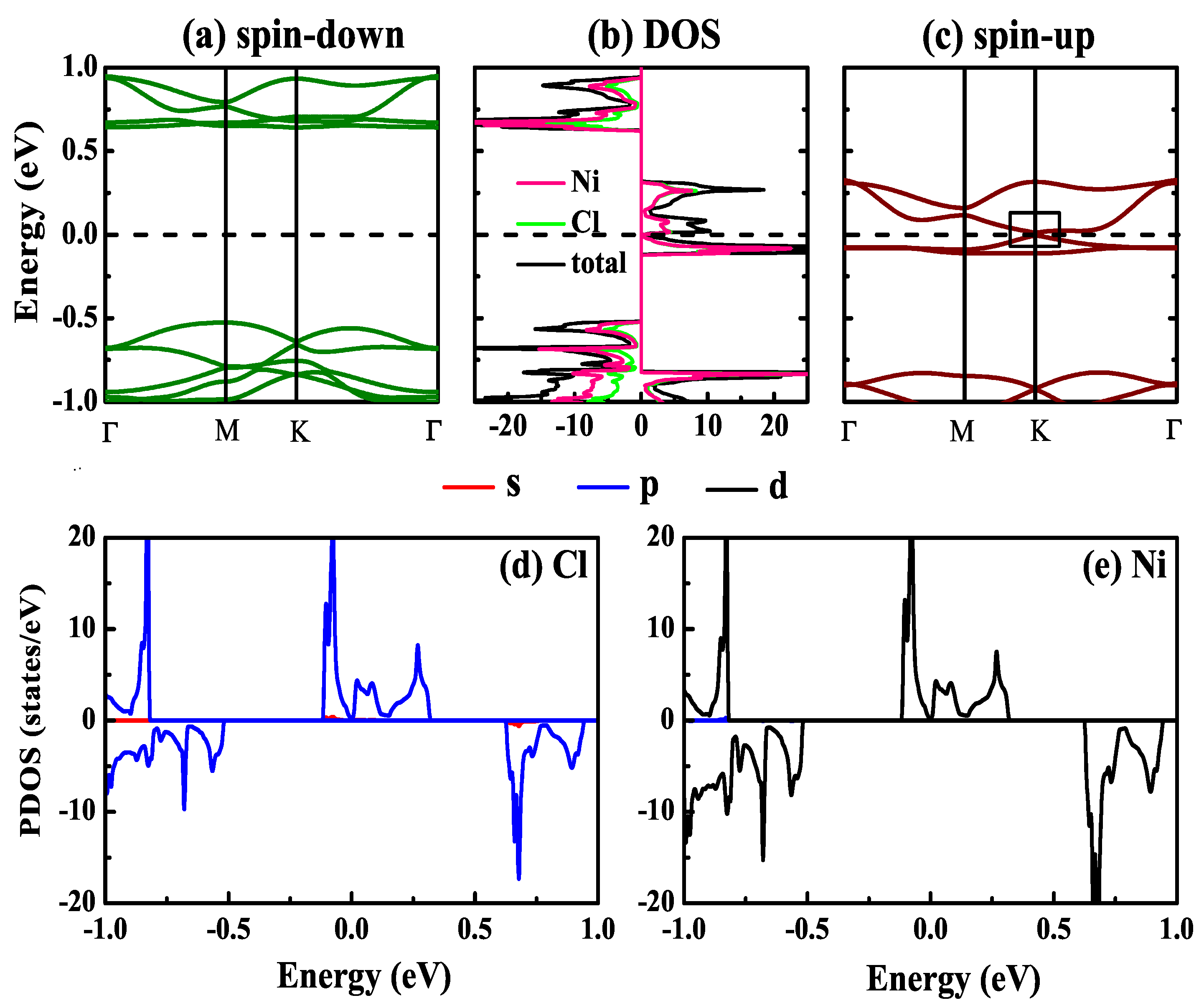
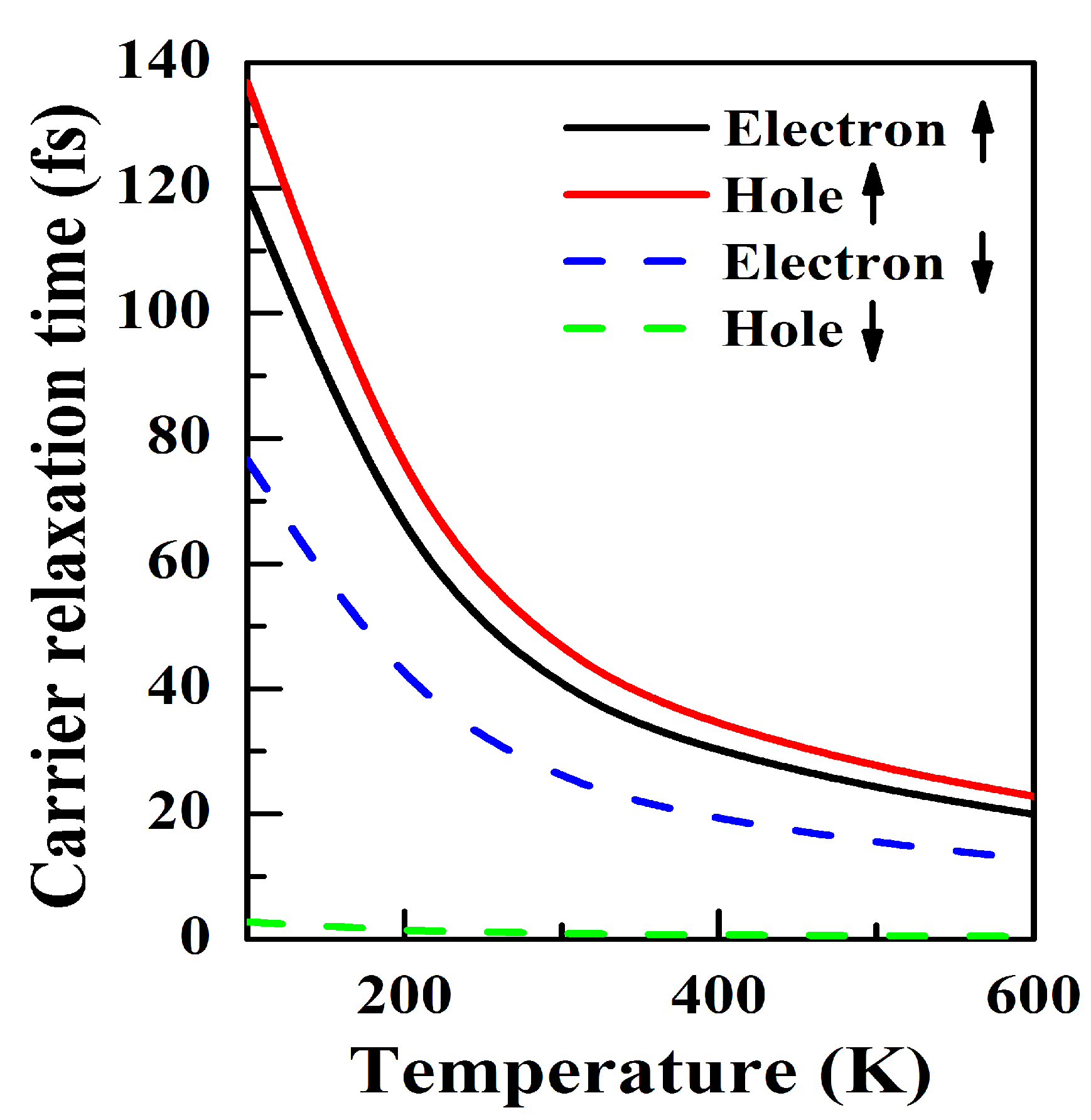
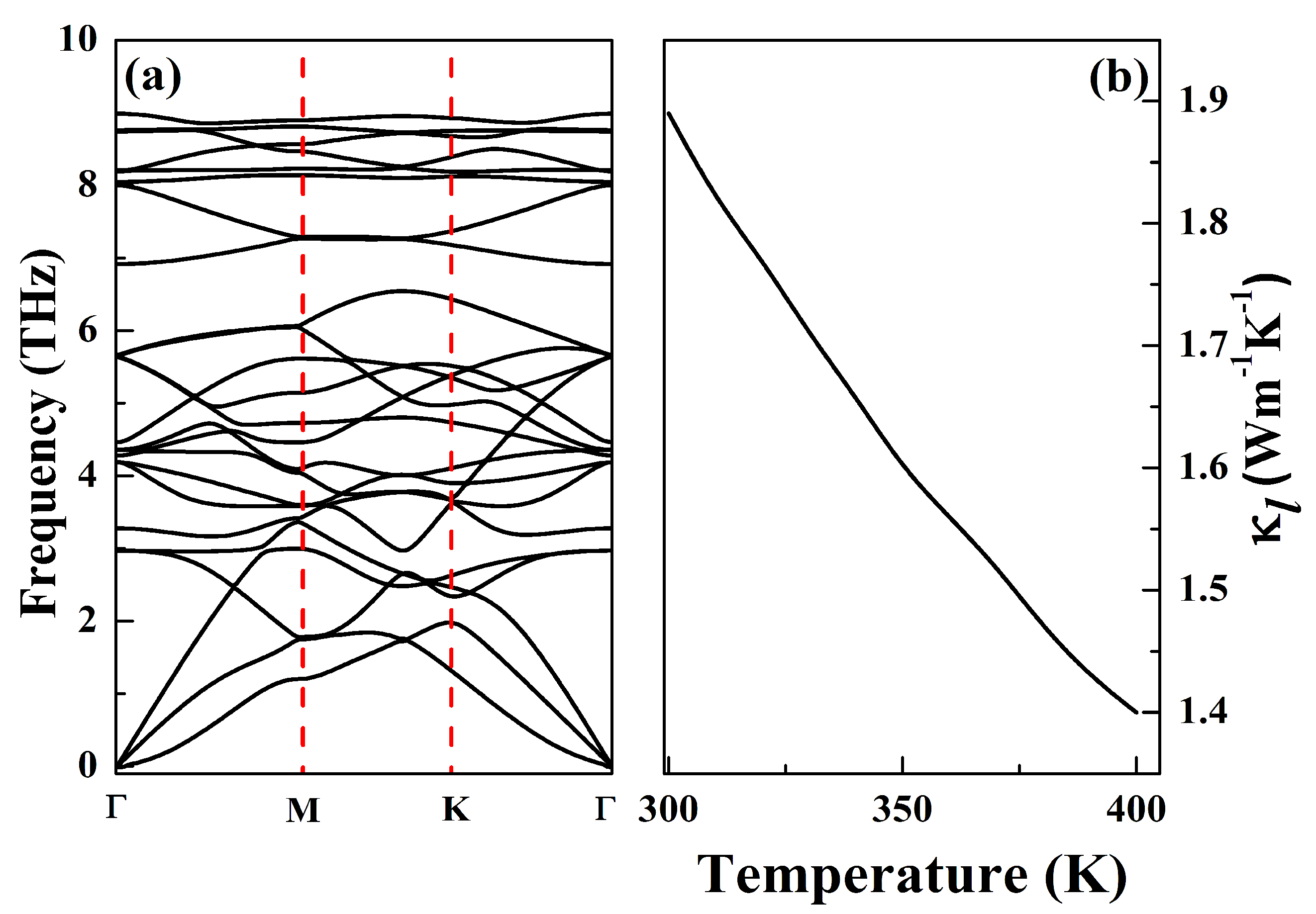
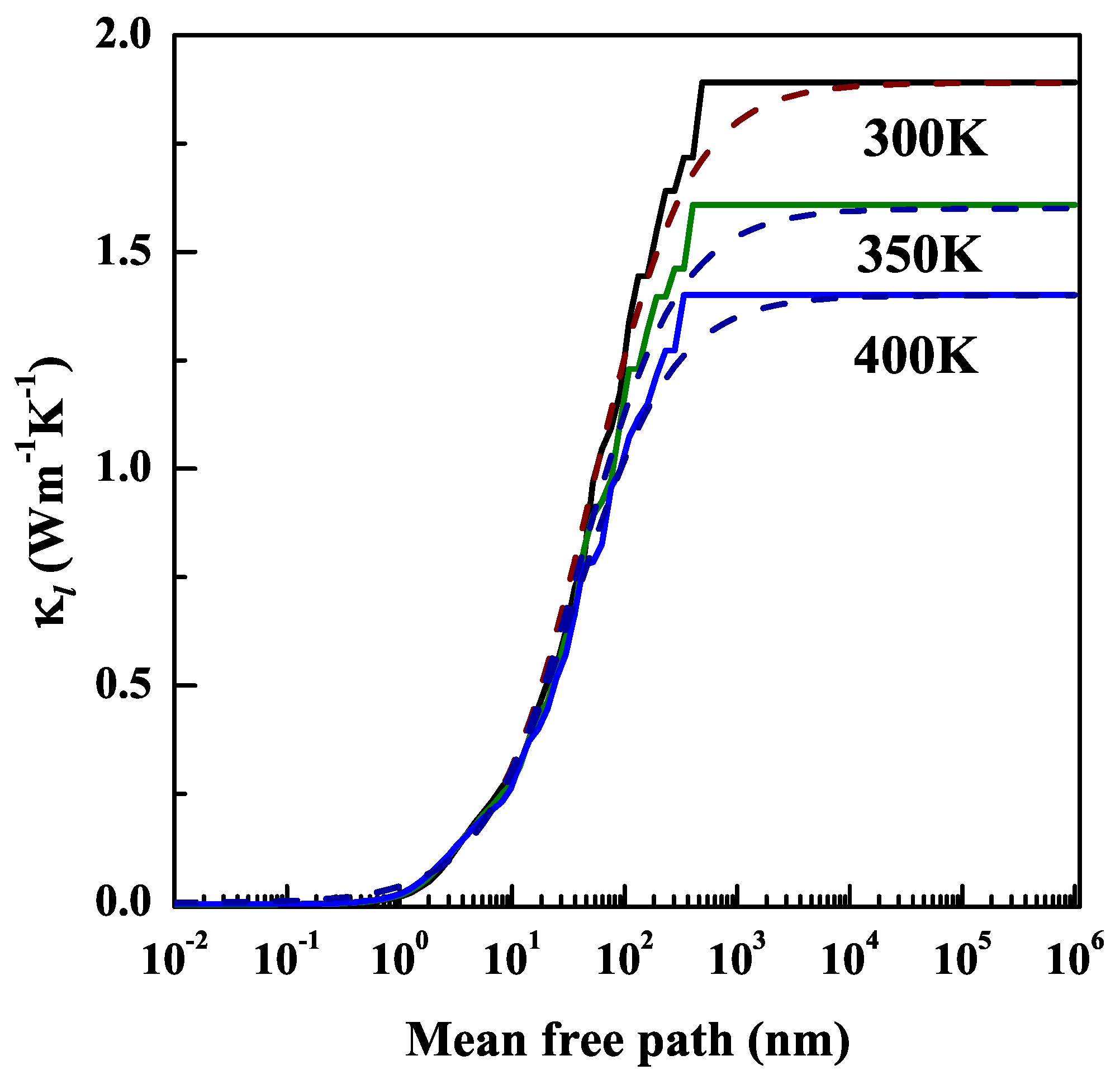
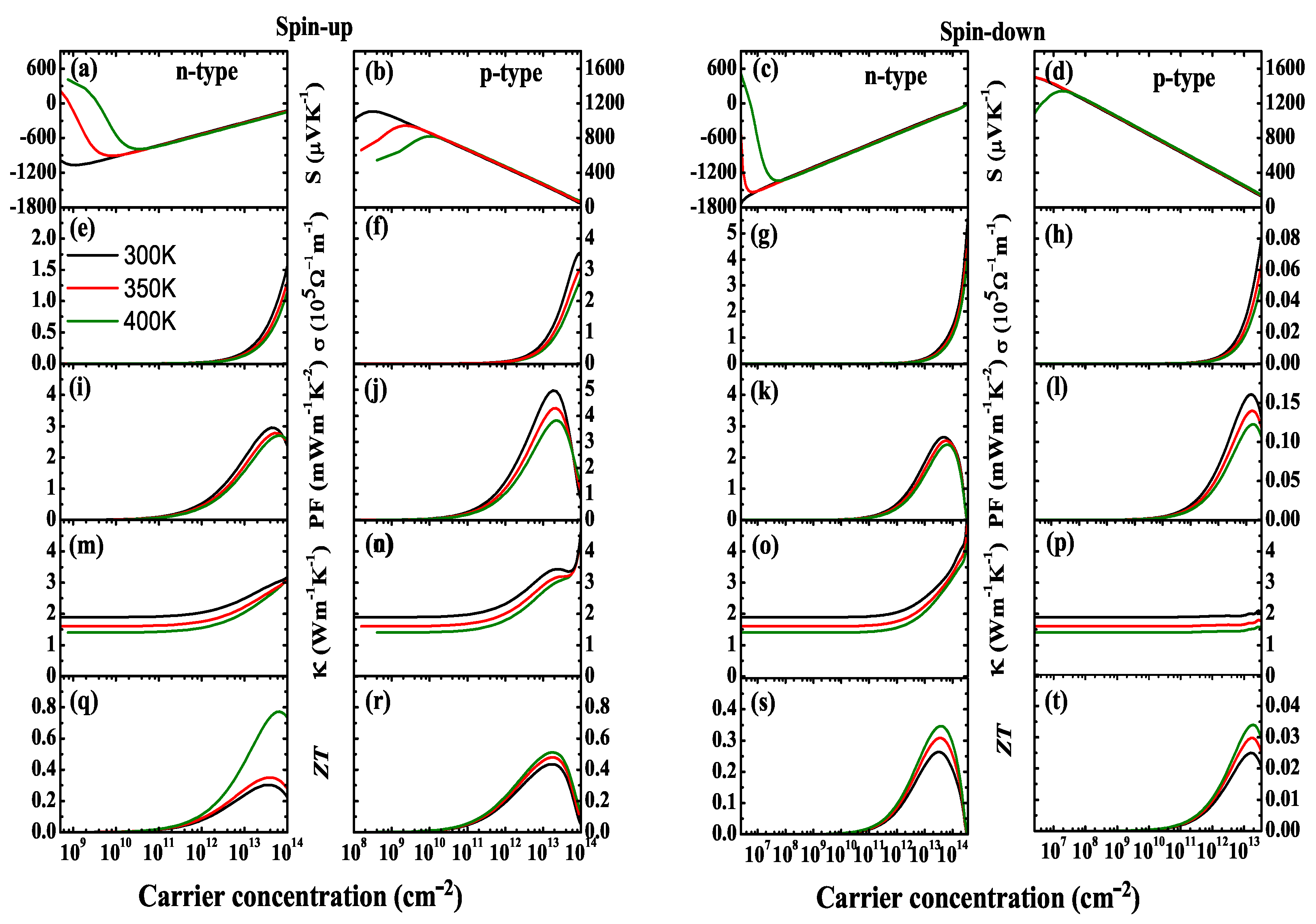
| Spin Direction | Carrier Type | (m) | (m) | (N/m) | (eV) | (×10 cm V s) | (fs) |
|---|---|---|---|---|---|---|---|
| Spin up | Electron | 0.28 | 0.21 | 154.5 | 7.52 | 1.01 | 159.9 |
| Hole | 0.23 | 0.18 | 154.5 | 7.52 | 1.39 | 182.7 | |
| Spin down | Electron | 0.95 | 1.48 | 154.5 | 3.53 | 0.19 | 102.0 |
| Hole | 6.10 | 8.29 | 154.5 | 7.76 | 0.001 | 3.8 |
© 2020 by the authors. Licensee MDPI, Basel, Switzerland. This article is an open access article distributed under the terms and conditions of the Creative Commons Attribution (CC BY) license (http://creativecommons.org/licenses/by/4.0/).
Share and Cite
Liu, J.; Chen, X.; Huang, Y.; Yuan, H.; Chen, H. Thermoelectric Properties of NiCl3 Monolayer: A First-Principles-Based Transport Study. Nanomaterials 2020, 10, 411. https://doi.org/10.3390/nano10030411
Liu J, Chen X, Huang Y, Yuan H, Chen H. Thermoelectric Properties of NiCl3 Monolayer: A First-Principles-Based Transport Study. Nanomaterials. 2020; 10(3):411. https://doi.org/10.3390/nano10030411
Chicago/Turabian StyleLiu, Jing, Xiaorui Chen, Yuhong Huang, Hongkuan Yuan, and Hong Chen. 2020. "Thermoelectric Properties of NiCl3 Monolayer: A First-Principles-Based Transport Study" Nanomaterials 10, no. 3: 411. https://doi.org/10.3390/nano10030411
APA StyleLiu, J., Chen, X., Huang, Y., Yuan, H., & Chen, H. (2020). Thermoelectric Properties of NiCl3 Monolayer: A First-Principles-Based Transport Study. Nanomaterials, 10(3), 411. https://doi.org/10.3390/nano10030411






